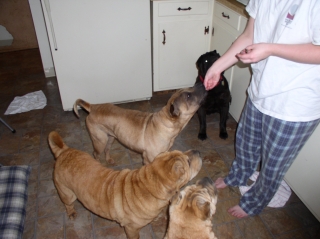A Thousand Words

As a behavior consultant, I am often asked to assess the behavior of a client’s dog based on their interpretation of what they think their dog is doing and what his motives are. For example, some recent comments include:
“She is very dominant of her toys and things she thinks are hers.”
“Even with someone holding her, she still wanted to continue attacking.”
“He really wants to be a part of his owner’s life. He really wants to please – you can just see it in his face...the way he turns his head up when he does something right with almost a smile of excitement.”
“After this incident...Buddy remained angry at our friends.”
One of the most difficult aspects of working as a behavior consultant is finding the useful information in these descriptions from clients. Sometimes it is simply a matter of asking the right questions in the right way, like “tell me what that looked like; what was your dog’s body/head/face doing right before that happened, and right after?” But other times it is difficult to get an emotional client to paint a picture without coloring it with their emotions.
I have found it increasingly helpful to have clients video their dogs behavior. If I can see the dog performing his rituals, without the impedance of having a stranger there watching his every move (which inevitably happens when I observe in person), then I can objectively assess the behavior without an emotional attachment. I can also then narrate the video for the client to draw their attention to early signals they have been missing. This allows us to move passed “why” the undesirable behavior is happening and onto predicting and preventing it, and teaching the dog what to do instead.
If you are seeking help from a behavior consultant, here are my recommendations for video.
DO NOT set your dog up to perform an undesirable behavior. If it has been happening and you’re having trouble altering it, it will happen. Carry a portable video camera with you on walks and around the house (those belt clips for our increasingly higher-resolution camera phones are fairly inexpensive). Shoot the video when it happens on its own. If you know it’s going to happen, be ready, but don’t set it up!
Try and begin the video right before the behavior begins or as close to the beginning as possible.
Act as you normally would act when this behavior happens. I want to see what you’ve been trying.
THEN (after #3) try not reacting at all. This is to test if your behavior plays a role in the outcome, and what role that might be. Obviously if safety is a concern, safety comes first.
Also shoot some video of your dog performing desirable behaviors or normal routines. It is good to have a comparison of your dog’s ‘Dr. Jekyll & Mr Hyde.’
Post the video to YouTube and send me a link. This is MUCH less time-consuming for you and for me than to attach, send, and download a huge video file. You can create a YouTube account for free and make your videos private and only viewable to those who have a link.




